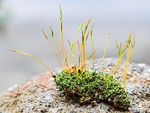Nature in the News - CSU, Chico
←
→
Page content transcription
If your browser does not render page correctly, please read the page content below
Nature in the News
Every year, scientists around the world work hard to learn more and
answer questions about our universe. What discoveries about the
natural world have scientists made in the past year?
We’ve selected some of our favorite discoveries about plants, animals and
ecology in 2020. Create a collage and showcase these discoveries by
cutting out the images and gluing them to a background or craft materials!New Plant Species
October 6, 2020
When a forestland in Switzerland was
converted over 150 years into a grassland
pasture for grazing livestock, the plants
that lived there had to adapt. Scientists
discovered a new species of bittercress,
called Cardamine insueta, that had
evolved for the new grassland habitat
from its forest-growing “parent plants.”
Image: EurekAlert.org
Nutrients in Plant Droplets
September 29, 2020
Have you ever seen droplets of
water on the edges of leaves?
This sugary, sappy liquid is
produced by the leaves in a
process “guttation,” and
scientists have learned that this
liquid is full of nutrients that
feed hungry insects!
Using Technology to Count
Plants in the Desert
December 7, 2020
Using special cameras and computer
algorithms, conservation scientists
were able to count every single
creosote plant (Larrea tridentata) in
a 135 square mile section of the
Mojave Desert. They found 23
million plants!Recreating Martian Soil
October 27, 2020
Geologists are using soil sample
data from the Mars rovers to
recreate artificial Martian soil and
learn whether it could support
growing plant life.
Image: NASA / JPL / Cornell University
How Venus Flytraps Snap
July 10, 2020
Plant scientists have known that the Venus
flytrap closes up on its prey when these insect
critters, like flies, brush the hairs inside the
plant twice within 30 seconds. We now know
that slow-moving prey, like larvae or snails,
can also trigger the plant to close if they touch
the hairs just once but for a longer time.
Attracting Urban Bees
July 15, 2020
Ecologists studying plant-pollinator
interactions have learned that community
gardens in cities attract similar numbers and
types of pollinators as rural areas, and that
other urban spaces like parks and cemeteries
could also support healthy pollinators if a
wide diversity of native plants are grown.Giant Sequoia Bark
June 17, 2020
How do giant sequoia trees protect
themselves? We now know that the bark
of these trees is made up of a complicated,
insulating 3-D network of fibers that
compress and return almost completely to
normal after impacts like fire or falling
rocks – similarly to how a pillow bounces
back under the pressure of your head!
Image: Bold et al. 2020
Rainfall Impact on Pine Needles
September 29, 2020
Pine trees have evolved special fibers in their
needle-like leaves that help protect them from
heavy rain. Many other plants have round
fibers, but these ones are angled and split the
falling raindrops in a way that makes them
gentler on the needles. This discovery could
help us design better waterproof materials!
Mosses Travel the Globe Using Wind
November 10, 2020
Mosses are special types of plants called
“bryophytes” that don’t have roots. This year,
scientists compared the spread of mosses around
the world with global wind patterns. They learned
that the “spores”, or special seed-like structures of
mosses, travel between continents by floating high
above the ground in the wind.Learn More
You can read more about each of these science news
stories using the links below to the press releases and
the scientific papers produced by the researchers!
New Plant Species: Cardamine insueta
Science Daily Press Release: Evolution in action: New Plant species in the Swiss Alps
Journal Reference: Jianqiang Sun, Rie Shimizu-Inatsugi, Hugo Hofhuis, Kentaro Shimizu, Angela Hay,
Kentaro K. Shimizu, Jun Sese. A Recently Formed Triploid Cardamine insueta Inherits Leaf
Vivipary and Submergence Tolerance Traits of Parents. Frontiers in Genetics, 2020; 11
DOI: 10.3389/fgene.2020.567262
Nutrients in Plant Droplets
Science Daily Press Release: Plant droplets serve as nutrient-rich food for insects
Journal Reference: Pablo Urbaneja-Bernat, Alejandro Tena, Joel González-Cabrera, Cesar
Rodriguez-Saona. Plant guttation provides nutrient-rich food for insects. Proceedings of the
Royal Society B: Biological Sciences, 2020; 287 (1935): 20201080 DOI: 10.1098/rspb.2020.1080
Using Technology to Count Plants in the Desert
Science Daily Press Release: ‘Big data’ enables first census of desert shrub
Journal Reference: James H. Gearon, Michael H. Young. Geomorphic controls on shrub canopy
volume and spacing of creosote bush in northern Mojave Desert, USA. Landscape
Ecology, 2020; DOI: 10.1007/s10980-020-01149-8
Recreating Martian Soil
Science Daily Press Release: Geologists simulate soil conditions to help grow plants on Mars
Journal Reference: Laura E. Fackrell, Paul A. Schroeder, Aaron Thompson, Karen Stockstill-
Cahill, Charles A. Hibbitts. Development of Martian regolith and bedrock simulants: Potential
and limitations of Martian regolith as an in-situ resource. Icarus, 2021; 354: 114055
DOI: 10.1016/j.icarus.2020.114055
How Venus Flytraps Snap
Science Daily Press Release: How Venus flytraps snapJournal Reference: Jan T. Burri, Eashan Saikia, Nino F. Läubli, Hannes Vogler, Falk K. Wittel,
Markus Rüggeberg, Hans J. Herrmann, Ingo Burgert, Bradley J. Nelson, Ueli
Grossniklaus. A single touch can provide sufficient mechanical stimulation to trigger
Venus flytrap closure. PLOS Biology, 2020; 18 (7): e3000740
DOI: 10.1371/journal.pbio.3000740
Attracting Urban Bees
Science Daily Press Release: Urban bees: Pollinator diversity and plant interactions in
city green spaces
Journal Reference: Benjamin Daniels, Jana Jedamski, Richard Ottermanns, Martina Ross-
Nickoll. A “plan bee” for cities: Pollinator diversity and plant-pollinator interactions
in urban green spaces. PLOS ONE, 2020; 15 (7): e0235492
DOI: 10.1371/journal.pone.0235492
Giant Sequoia Bark
Science Daily Press Release: How the giant sequoia tree protects itself
Journal Reference: Georg Bold, Max Langer, Laura Börnert, Thomas Speck. The Protective
Role of Bark and Bark Fibers of the Giant Sequoia (Sequoiadendron giganteum)
during High-Energy Impacts. International Journal of Molecular Sciences, 2020; 21 (9):
3355 DOI: 10.3390/ijms21093355
Rainfall Impact on Pine Needles
Science Daily Press Release: Evolution of pine needles helps trees cope with rainfall impact
Journal Reference: Amy P. Lebanoff, Andrew K. Dickerson. Drop impact onto pine needle
fibers with non-circular cross section. Physics of Fluids, 2020; 32 (9): 092113
DOI: 10.1063/5.0019310
Mosses Travel the Globe Using Wind
Science Daily Press Release: Researchers discover the secret of how moss spreads
Journal Reference: Elisabeth M. Biersma, Peter Convey, Rhys Wyber, Sharon A. Robinson,
Mark Dowton, Bart van de Vijver, Katrin Linse, Howard Griffiths, Jennifer A.
Jackson. Latitudinal Biogeographic Structuring in the Globally Distributed Moss
Ceratodon purpureus. Frontiers in Plant Science, 2020; 11
DOI: 10.3389/fpls.2020.502359You can also read

























































